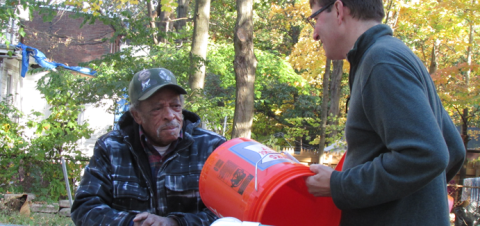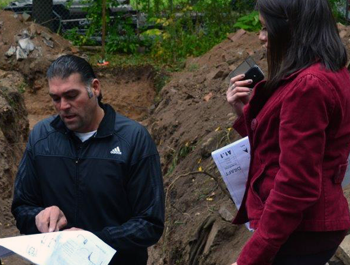Image

James A. Paley, Executive Director, Neighborhood Housing Services of New Haven
Challenge: A 2012 survey by Neighborhood Housing Services of New Haven (NHSNH) found that many residents in the Newhallville neighborhood of New Haven, Connecticut felt disconnected from their community and unsafe. Many respondents wanted to become more involved in their community but unsure how to help most effectively.
Newhallville, a six-by-eight block neighborhood of New Haven, Connecticut with a population of nearly 8,500, was once known as a bedroom community for employees of the Winchester Repeating Arms Company from 1866 until the manufacturer's decline in the 1980s. When the company reduced production, many employees lost their jobs and either left New Haven or remained and experienced economic distress.
A drastic drop in population left houses abandoned and prone to blight, forced businesses to close and created an environment that fostered crime and gang violence. Neighborhood Housing Services of New Haven (NHSNH) committed to restoring Newhallville to its former vibrancy. The organization acquires and rehabilitates blighted properties, offers pre- and post-purchase homebuyer education and works with residents to help them take charge of their neighborhood.
The Community Building and Organizing (CB&O) team at the agency distributes Success Measures surveys periodically to gauge residents' feelings about issues in the community. In the 2012 survey, residents expressed their dissatisfaction with the quality and safety of outdoor community spaces. For instance, 45 percent of respondents ranked the quality of parks, playgrounds and outdoor recreation centers as "poor" or "very poor," while 35 percent of respondents perceived the safety of children playing outside as "not that safe" or "not safe at all."
While these results did not come as a surprise, they did allow the CB&O staff at NHS to better direct their efforts in working with resident leaders to address the most important issues. The CB&O team and resident leaders who participated in the Community Leadership Institute (CLI) in Orlando, FL identified improving outdoor community spaces as a top priority and envisioned a community greenhouse in the Ivy Street Community Garden.
 The Ivy Street Community Garden was only used by 10 resident gardeners, but its size and location made it a perfect place for a community greenhouse. Neighbors imagined this community green space not only as an educational area to be used by local schools and families, but also as a source of fresh produce for neighbors year-round.
The Ivy Street Community Garden was only used by 10 resident gardeners, but its size and location made it a perfect place for a community greenhouse. Neighbors imagined this community green space not only as an educational area to be used by local schools and families, but also as a source of fresh produce for neighbors year-round.Resident leaders and agency staff members reached out to their networks to promote the garden and greenhouse as a community space. Local groups including the Ivy Street Gardeners, City Seed and the New Haven Land Trust became involved in the project. Young people began using the garden when the neighboring Lincoln-Basset Elementary School and Solar Youth, a nonprofit that supports youth in low-income neighborhoods, began offering outdoor education. As partnerships developed, more people became involved with the care and maintenance of the garden and excitement began to build among participants.
Resident leaders worked alongside various partners to secure funding for the project. They produced detailed site drawings, advocated for the project during Newhallville Community Management Team meetings and made a formal request to the City of New Haven (the landowner) for specific changes to the site. Once the appropriate approvals were in place, construction of a 15-by-30-foot greenhouse was completed with help from the United Way of Greater New Haven and PCL Walsh Company Venture II.
Today, the Ivy Street Community Garden greenhouse stands on the corner of Ivy Street and Shelton Avenue in Newhallville. The structure's success has not been without setbacks, however. During the winter of 2014, the greenhouse collapsed under record snowfall. Gardeners were frustrated, but bonds were strengthened as gardeners and community partners came together to repair the greenhouse and rebuild it into an educational and environmental oasis for all.
While the site is collectively maintained, resident gardeners continue to take a leadership role in programming for the greenhouse. A number of organizations continue to use the greenhouse including Lincoln-Basset School, Solar Youth, Squash Haven, Sound School, Common Ground High School and Yale University's Dwight Hall student groups. Resident gardeners take the initiative to engage with young people and share their knowledge.
The garden also serves as a place of remembrance for Al, Robert and Leroy, three resident gardeners who passed away since the inception of the project in 2012. Through this emotionally difficult time, the garden provided space to pay tribute to those who revitalized the garden.
Through the Ivy Street Community Garden project, NHSNH learned two lessons, including:
- The project's success can be credited to the fact that residents were given a chance to have their voices heard and truly lead a project at their own pace from conception to completion, through the various trials and tribulations of its execution.
- The role of the organization is to support residents in their efforts using its network to secure funding and government approvals and to garner community involvement.

